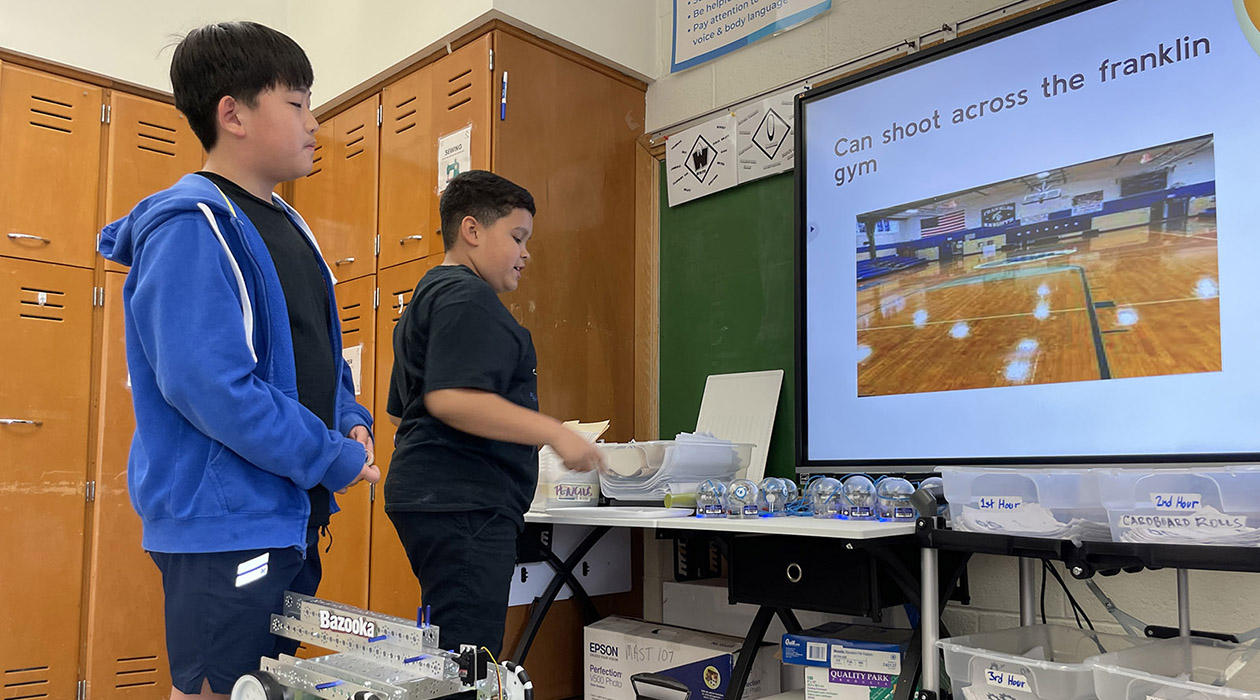STEAM TRAIN pulls into the station for another successful year

STEAM TRAIN students show off their project, Bazooka, engineered to shoot candy. Their presentation listed additional Bazooka features including "If you take the cannon off, it becomes a tray." / Julia Pollack
An engineered bazooka designed to launch candy, a 3D-printed novel board game, an ecological experiment with fish, and a magnetically powered trebuchet. You may guess that these are all projects designed by undergraduate or even graduate level students for a class. However, these projects are the curiosity-driven creations of middle schoolers as part of the STEAM (Science, Technology, Engineering, Arts, and Mathematics) TRAIN (Transdisciplinary Research Across Institutional Near-peers) program, which just completed its third successful year.
STEAM TRAIN, which partners the University of Illinois Urbana-Champaign with the Champaign Franklin STEAM Academy, is organized by the IGB’s Senior Outreach Activities Coordinator Daniel Urban, Franklin’s Magnet Site Coordinator Zanne Newman, and University Laboratory High School’s teacher Melinda Tidrick, and is funded by the University of Illinois’ Community Research Partnership Program. The program encourages independent, student-inspired research by allowing middle school students to dream up any kind of science or engineering project they want. Mentors in the program then help guide the design of the project and provide the necessary tools to make the idea feasible and achievable.
This year, four groups of students met weekly after school to work on their research projects from September 2022 till May 2023. During these meetings, they received mentoring from researchers at the Carl R. Woese Institute for Genomic Biology, along with high school students from Uni High.
At the end of the semester, the teams gathered to show off their final creations or research findings, complete with impressive slideshow presentations with data and graphs to match. Some projects even rivaled the caliber and level of design that might be expected of college students. The teams not only presented their findings, but also discussed potential real work applications of their work, the limitations, and the insights they gained.
“Working with the kids for STEAM TRAIN is always a blast,” said Danny Ryerson, IGB’s Outreach Activities Coordinator. “They are great students, and I am always excited to see what research questions they decide to pursue. For many of the kids, this is their first opportunity to take charge of a science project and decide what they want to research. This can lead to really driven researchers and some amazing results.”
One team found clear differences in fish survival based on temperature that they related to the impacts of global warming. Another team found that they could consistently get their bazooka to shoot tiny projectiles over 45 feet after tinkering with the stability of the design. During the trebuchet team’s demonstration, the students explained how magnetic attraction creates force energy that quickly rotates the trebuchet's arm, clarifying that this was different from the kinetic energy that standard trebuchets use.
While watching students present their data, it was clear that through running these projects, students were also inadvertently learning advanced concepts in scientific testing, such as the need for larger sample sizes and consistent methodology. These concepts were echoed during a conversation with one student on the trebuchet team, named Anna, about her experience:
“My favorite part was recording our data, because sometimes it failed, and sometimes it worked really well. And it would be funny because when it failed, it would usually be a dumb mistake, like we forgot a step. But it taught us to be very accurate with what we were doing, because a slight difference can have a huge impact on your results.”
Another team designed a robot-themed board game, called “BOT 1 2 3!”, the goal of which was to enter the other player’s base and take their pawns, similar to chess. However, the game has an added layer of walls, which break up the board and add complexity to how pawns reach the other side. When Natan, one of the students on the team, was asked about the inspiration for the project, he said it had started as a video game design inspired by the popular video game Five Nights at Freddy's. “But when that didn't work, we switched to doing a board game, and then the game took on a different path entirely,” Natan said. “I still want to learn more code in the future though so I can make the video game version!” When asked if he had any other thoughts about his experience making the game, he said “I’ll summarize it in one word – BOT.”

